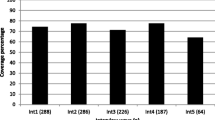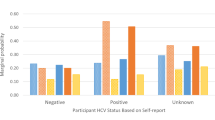Abstract
Needle-exchange programs (NEPs) have been shown to be effective in reducing barm related to injection drug use and to act as an important link between the injection drug using community and preventive/treatment services. Different needle-exchange distribution methods may reach different subpopulations of injecting drug users (IDUs). We undertook this study to characterize risk behaviors by primary source of clean needles accessed by IDUs in a city with pharmacy access and fixed and mobile exchange programs. We hypothesized there would be a gradient of risk across the three types of distribution. Data were collected from within the Vancouver Injection Drug Users Study (VIDUS), a prospective cohort study. Participants who primarily obtained clean needles from pharmacies, fixed sites, or mobile exchange vans were compared using the Cochran-Armitage trend test to test for trends in increasing risk behaviors across the three types of distribution. Ordinal multivariate regression was used to adjust the associations for potential confounders. Results illustrate clear trends for increasing risk profiles from pharmacy to fixed site to mobile exchange vans. Van users were generally at higher risk than fixed-site and pharmacy users. Independent predictors of van use were fewer years injecting, difficulty finding needles, Aboriginal ethnicity, incarceration in the previous 6 months, and injecting cocaine daily. An important component of needle-exchange programs is outreach to access those who are at highest risk. Use of distribution beyond fixed sites will improve such outreach, thereby increasing program effectiveness and further preventing the transmission of blood-borne infections.
Similar content being viewed by others
References
Des Jarlais DC, Marmor M, Paone D, et al. HIV incidence among injecting drug users in New York City syringe-exchange programmes. Lancet. 1996;348(9033):987–991.
Kaplan EH, Heimer RHIV incidence among New Haven needle exchange participants: updated estimates from syringe tracking and testing data. J Acquir Immune Defic Syndr. 1995;10(2):175–176.
Vlahov D, Junge B. The role of needle exchange programs in HIV prevention. Public Health Rep. 1998;113(suppl 1):75–80.
Hagan H, Jarlais DC, Friedman SR, Purchase D, Alter MJ. Reduced risk of hepatitis B and hepatitis C among injection drug users in the Tacoma syringe exchange program. Am J Public Health. 1995;85(11):1531–1537.
Strathdee SA, Patrick DM, Currie SL, et al. Needle exchange is not enough: lessons from the Vancouver injecting drug use study. AIDS. 1997;11(8):F59-F65.
Bruneau J, Lamothe F, Franco E, et al. High rates of HIV infection among injection drug users participating in needle exchange programs in Montreal: results of a cohort study. Am J Epidemiol. 1997;146(12):994–1002.
van Ameijden EJ, van den Hoek AR, Coutinho RA. Injecting risk behavior among drug users in Amsterdam, 1986 to 1992, and its relationship to AIDS prevention programs. Am J Public Health. 1994;84(2):275–281.
Keene J, Stimson GV, Jones S, Parry-Langdon N. Evaluation of syringe-exchange for HIV prevention among injecting drug users in rural and urban areas of Wales. Addiction. 1993;88(8):1063–1070.
van Ameijden EJ, Coutinho RA. Maximum impact of HIV prevention measures targeted at injecting drug users. AIDS. 1998;12(6):625–633.
Drucker E, Lurie P, Wodak A, Alcabes P. Measuring harm reduction: the effects of needle and syring exchange programs and methadone maintenance on the ecology of HIV. AIDS. 1998;12(suppl A):S217-S230.
Guydish J, Bucardo J, Clark G, Bernheim S. Evaluating needle exchange: a description of client characteristics, health status, program utilization, and HIV risk behavior. Subst Use Misuse. 1998;33(5):1173–1196.
Strathdee SA, Celentano DD, Shah N, et al. Needle-exchange attendance and health care utilization promote entry into detoxification. J Urban Health. 1999;76(4):448–460.
Hankins CA. Syringe exchange in Canada: good but not enough to stem the HIV tide. Subst Use Misuse. 1998;33(5):1129–1146.
Bluthenthal RN. Syringe exchange as a social movement: a case study of harm reduction in Oakland, California. Subst Use Misuse. 1998;33(5):1147–1171.
Heimer R. Syringe exchange programs: lowering the transmission of syringe-borne diseases and beyond. Public Health Rep. 1998;113(suppl 1):67–74.
Lurie P, Gorsky R, Jones TS, Shomphe L An economic analysis of needle exchange and pharmacy-based programs to increase sterile syringe availability for injection drug users. J Acquir Immune Defic Syndr Hum Retrovirol. 1998;18(suppl 1):S126-S132.
Des Jarlais DC. Research, politics, and needle exchange. Am J Public Health. 2000;90(9):1392–1394.
Schechter MT, Strathdee SA, Cornelisse PG, et al. Do needle exchange programmes increase the spread of HIV among injection drug users? An investigation of the Vancouver outbreak. AIDS. 1999;13(6):F45-F51.
Hagan H, McGough JP, Thiede H, Hopkins SG, Weiss NS, Alexander ER. Volunteer bias in nonrandomized evaluations of the efficacy of needle-exchange programs. J Urban Health. 2000;77(1):103–112.
Hahn JA, Vranizan KM, Moss AR. Who uses needle exchange? A study of injection drug users in treatment in San Francisco, 1989–1990. J Acquir Immune Defic Syndr Hum Retrovirol. 1997;15(2):157–164.
Riley ED, Safaeian M, Strathdee SA, et al. Comparing new participants of a mobile versus a pharmacy-based needle exchange program. J Acquir Immune Defic Syndr. 2000;24(1):57–61.
Vancouver Police Department Report. Downtown-Eastside: a Community Profile. Vancouver: Vancouver Police Dept; 1994.
Schechter MT, O’Shaughnessy MV. Distribution of Injection Drug Users in the Lower Mainland. A Brief Report for the Vancouver/Richmond Health Board. Vancouver, BC: Centre for Evaluation and Outcome Sciences; 1999.
Moss AR. “For God’s sake, don’t show this letter to the president...” Am J Public Health. 2000;90(9):1395–1396.
Gibson DR, Flynn NM, Perales D. Effectiveness of syringe exchange programs in reducting HIV risk behavior and HIV seroconversion among injecting drug users. AIDS. 2001; 15(11):1329–1341.
Paone D, Des Jarlais DC, Gangloff R, Milliken J, Friedman SR. Syringe exchange: HIV prevention, key findings, and future directions. Int J Addict. 1995;30(12):1647–1683.
Chaisson RE, Bacchetti P, Osmond D, Brodie B, Sande MA, Moss AR: Cocaine use and HIV infection in intravenous drug users in San Francisco. JAMA. 1989;261(4):561–565.
Moss AR, Vranizan K, Gorter R, Bacchetti P, Watters J, Osmond D. HIV seroconversion in intravenous drug users in San Francisco, 1985–1990. AIDS. 1994;8(2):223–231.
Moss AR, Vranizan K. Charting the epidemic: the case study of HIV screening of injecting drug users in San Francisco, 1985–1990. Br J Addict. 1992;87(3):467–471.
Franken IH, Kaplan CD. Risk contexts and risk behaviors in the Euregion Maas-Rhein: the Boule de Neige intervention for AIDS prevention among drug users. AIDS Educ Prev. 1997;9(2):161–180.
Paone D, Clark J, Shi Q, Purchase D, Des Jarlais DC. Syringe exchange in the United States, 1996: a national profile. Am J Public Health. 1999;89(1):43–46.
Spittal PM, Schechter MT. Injection drug use and despair through the lens of gender. CMAJ. 2001;164(6):802–803.
Rothon DA, Mathias RG. Schechter MTP revalence of HIV infection in provincial prisons in British Columbia. CMAJ. 1994;151(6):781–787.
Dolan KA. Can hepatitis C transmission be reduced in Australian prisons? Med J Aust. 2001;174(8):378–379.
Paone D, Des Jarlais DC, Caloir S, Jose B, Shi Q, Friedman SR: Continued risky injection subsequent to syringe exchange use among injection drug users in New York City. AIDS Educ Prev. 1997;9(6):505–510.
De Irala J, Bigelow C, McCusker J, Hindin R, Zheng L. Reliability of self-reported human immunodeficiency virus risk behaviors in a residential drug treatment population. Am J Epidemiol. 1996;143(7):725–732.
Latkin CA, Vlahov D, Anthony JC Socially desirable responding and self-reported HIV infection risk behaviors among intravenous drug users. Addiction. 1993;88(4):517–526.
Author information
Authors and Affiliations
Corresponding author
Rights and permissions
About this article
Cite this article
Miller, C.L., Tyndall, M., Spittal, P. et al. Risk-taking behaviors among injecting drug users who obtain syringes from pharmacies, fixed sites, and mobile van needle exchanges. J Urban Health 79, 257–265 (2002). https://doi.org/10.1093/jurban/79.2.257
Issue Date:
DOI: https://doi.org/10.1093/jurban/79.2.257




